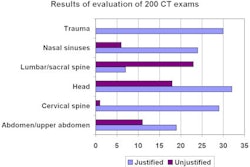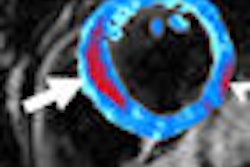MRI and MDCT assessments of left ventricular functional parameters were inaccurate when evaluated on a moving heart phantom with known parameters, according to research published in the March issue of European Radiology. CT, particularly dual-source CT, did outperform MRI, however.
The study found that MRI structurally underestimated functional parameters, ejection fraction, and cardiac output, while 64-detector-row CT either underestimated or overestimated the same parameters depending on the patient's heart rate. Dual-source CT had the smallest deviation compared to the other modalities.
Functional parameters of the left ventricle are closely related to cardiac morbidity and mortality, wrote Dr. Jaap Michiel Groen and colleagues from the University of Groningen in Groningen, Netherlands.
"These parameters can predict the prognosis of coronary artery disease in individual patients and in entire cohorts if assessed accurately," they wrote in European Radiology (March 2009, Vol. 19:3, pp. 577-583).
The current reference standard for assessing functional parameters is short-axis MRI using steady-state free precession sequences. On the plus side, MRI requires neither ionizing radiation nor nephrotoxic contrast agents. However, it is contraindicated in many patients.
Sixty-four-detector-row CT can be used as an alternative imaging modality, offering lower temporal resolution (165 msec) but higher spatial resolution (voxel size, 0.6 x 0.6 x 3.0 mm) compared to MRI (voxel size, 1.7 x 1.7 x 6.0 mm).
Dual-source CT has a temporal resolution similar to that of MRI (83 msec), combining relatively high temporal resolution with high spatial resolution (voxel size, 0.6 x 0.6 x 3.0 mm), the authors wrote.
Because CT is being used more frequently than cardiac MRI, and inasmuch as functional CT parameters can be calculated easily from gated CT data, it is important to understand the accuracy and limitations of CT for evaluating functional parameters, Groen and colleagues wrote.
The study compared 64-detector-row CT, MRI, and dual-source CT for the evaluation of ejection fraction and cardiac output in an anthropomorphic moving heart (Limbs & Things, Bristol, U.K.) operating at heart rates ranging from 50 to 100 bpm.
The parameters for 1.5-tesla MR (Magnetom Sonata, Siemens Healthcare, Erlangen, Germany) were TR 57.46/TE 1.10 msec, 59° alpha angle, 284 x 350-mm field-of-view, 125 x 192-mm matrix, 1.7 x 1.7 x 6-mm voxel size, and 4-mm interslice gap, with a retrospectively gated cine steady-state free precession sequence.
Single-source CT images were acquired on a Somatom Sensation 64-detector-row scanner (Siemens) at 330 msec, 3.0-mm slice thickness (increment, 3.0 mm), 120 kV, and 250 mAs. Dual-source CT data were acquired on a Somatom Definition scanner at 330 msec, 3.0-mm slice thickness (increment, 3.0 mm), 120 kV, and 120 mAs per rotation, a protocol similar to that of MDCT.
The MDCT and dual-source images were reconstructed at every 10% of the RR interval, with bisegmental reconstruction used at 64-detector-row CT for heart rates greater than 65 bpm. The group used single-segmental reconstruction for dual-source data.
Two readers, each with more than three years of experience evaluating cardiac function, evaluated the reconstructed axial images independently, using two dedicated postprocessing tools: QMass (Medis Medical Imaging Systems, Leiden, Netherlands) for the MRI and dual-source data and CardIQ (GE Healthcare, Chalfont St. Giles, U.K.) for the 64-detector-row CT data. Ejection fraction (EF) and cardiac output (CO) were calculated and compared using Bland-Altman plots.
Average end-diastolic volumes ranged from 263.2 to 269.6 mL for MRI, 274.6 to 283.2 mL for 64-detector-row CT, and 256.9 to 261.7 mL for dual-source CT, they wrote.
"End-diastolic volumes were exaggerated compared to the reference for all modalities except for dual-source CT," Groen and colleagues wrote.
End-systolic volumes were also exaggerated compared to the reference for all modalities except dual-source CT. Average end-systolic volumes ranged from 229.0 to 236.9 mL for MRI, 230.2 to 248.4 mL for 64-detector-row CT, and 219.8 to 220.6 mL for dual-source CT, the group reported.
MRI underestimated the ejection fraction by 16.1% (p < 0.01) with a Bland-Altman interval (B-A) of [-4.35 (-2.48) -0.60]. The error was smaller at 64-detector-row CT, which overestimated EF by 2.6% with a relatively wide B-A interval of [-3.40 (0.40) 4.20] (p = 0.62).
Dual-source CT yielded the smallest deviation from the known volumes of the cardiac phantom, with an underestimation of volumes by 0.8% with a B-A interval of [-1.17 (-0.13) 0.91].
The EF at dual-source CT showed both a small underestimation at lower heart rates and a small overestimation at higher heart rates; the average relative difference from the reference of 0.8% was not significant (p = 0.57).
The results were similar for cardiac output analysis. Cardiac output of the reference was larger at higher heart rates for all three modalities, Groen and colleagues reported.
Cardiac output by MRI was underestimated compared to the reference at all heart rates, with an average relative difference of -12.7% to the reference (p < 0.02). The CO by MDCT was overestimated versus the reference except at heart rates of 60 and 100 bpm, with an insignificant relative difference of 10.7% (p = 0.15). The CO by dual-source CT was slightly underestimated except at 100 bpm, with an average relative difference of 0.3% to the reference (p = 0.84).
MRI overestimated the end-diastolic volume and end-systolic volume structurally, leading to a structural underestimation of both EF and CO. The reason was limited spatial resolution, with a wide section thickness of 6 mm compared to other modalities.
"Sequences with higher spatial resolution are available for MRI, and it is expected that using these optimized sequences will improve the results," the authors wrote. "However, the duration of the scan will be increased."
The problem with MDCT was low temporal resolution, which caused blurring and complicated efforts to delineate the luminal cavity.
"Therefore, an observer might easily over- or underestimate a volume at an individual heart rate (e.g., the rather large deviation at 80 bpm), whereas the average measurement over all heart rates has a high accuracy," they wrote. "This explains the variable results with large limits of agreement for 64-slice MDCT."
Multisegment reconstruction can improve temporal resolution in phantoms, they added, but one study showed that the technique did not improve accuracy in human studies.
Dual-source CT approximated physical volumes the best with high spatial as well as temporal resolution, as shown in a previous phantom study by Mahnken et al. Previous comparisons performed in vivo have shown good approximations compared to MRI, but the results could not be compared with the known physical values of a phantom.
The main limitations of the study related to its use of a phantom, which performs somewhat differently and distributes contrast material differently than a human heart.
For example, the heart phantom has a fixed ejection fraction and cardiac output at a given heart rate, parameters that can vary in human patients. Also, the authors noted, trabecularization of the left ventricle in humans makes exact delineation of the endocardial border more dependent on visible contrast between the blood pool and the ventricular wall.
"Our results show that a clinically implemented MRI protocol structurally underestimates functional parameters, ejection fraction, and cardiac output of a moving heart phantom," Groen and colleagues concluded. "A clinical implemented protocol using 64-slice MDCT underestimates or overestimates these functional parameters depending on the heart rate. A clinical protocol using dual-source CT deviates the least from these functional parameters compared to MRI and 64-slice MDCT."
By Eric Barnes
AuntMinnie.com staff writer
February 20, 2009
Related Reading
Rheumatoid arthritis associated with increased left ventricular mass, January 23, 2009
MRI beats PET for myocardial evaluation in patients with impaired LV function, January 9, 2009
Overweight kids have worse cardiac ventricular function, November 13, 2008
Cardiac function normal in children with perinatal glucocorticoid exposure, August 25, 2008
PET, SPECT measures of LVEF have superior predictive value, March 13, 2006
Copyright © 2009 AuntMinnie.com


















